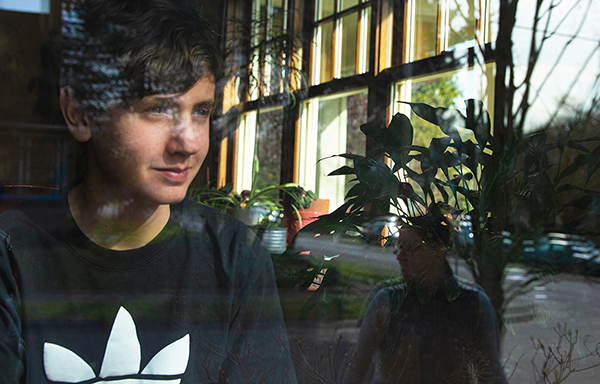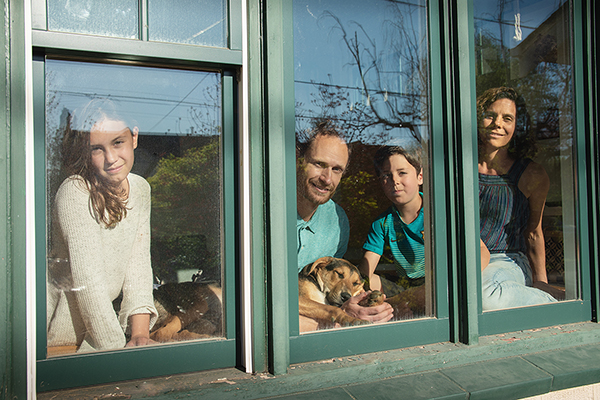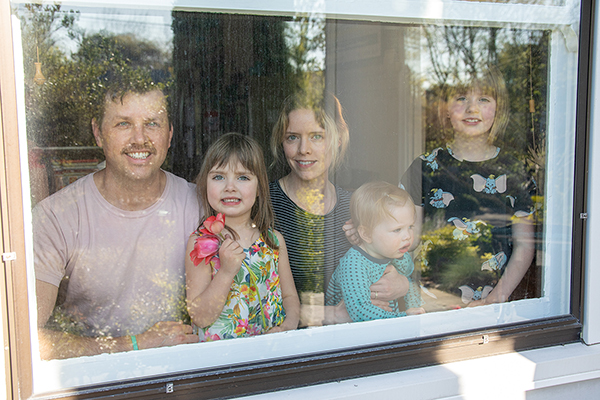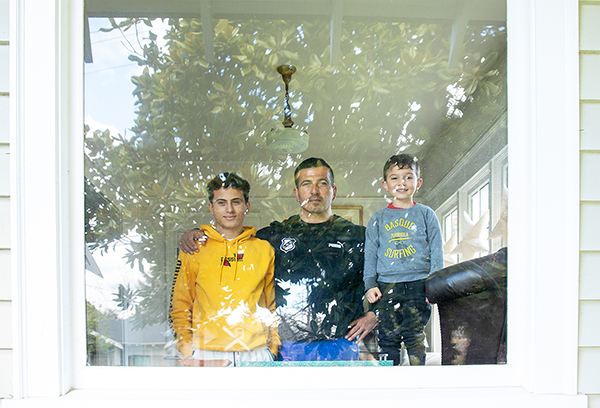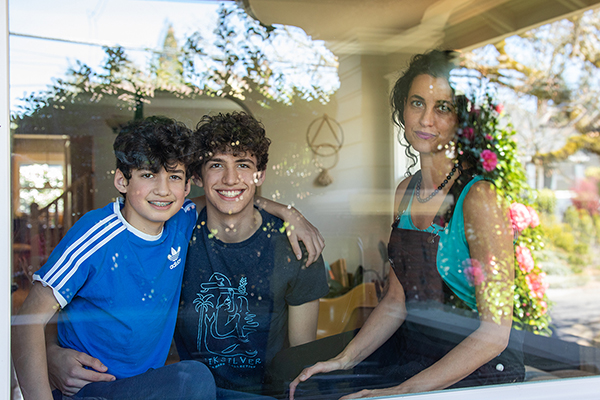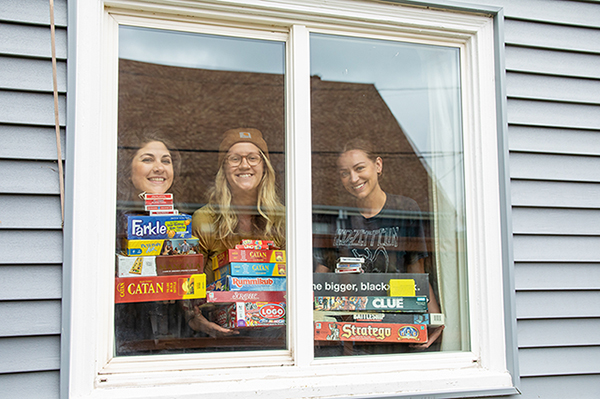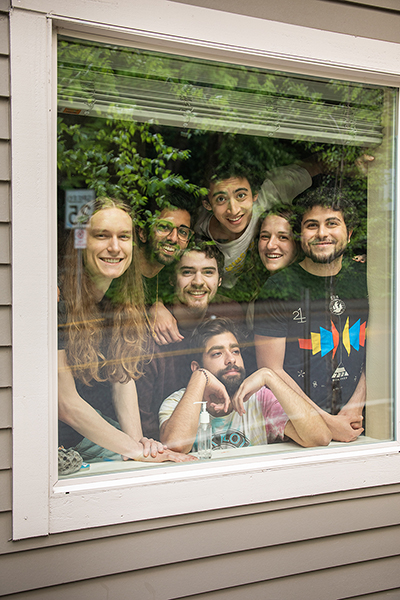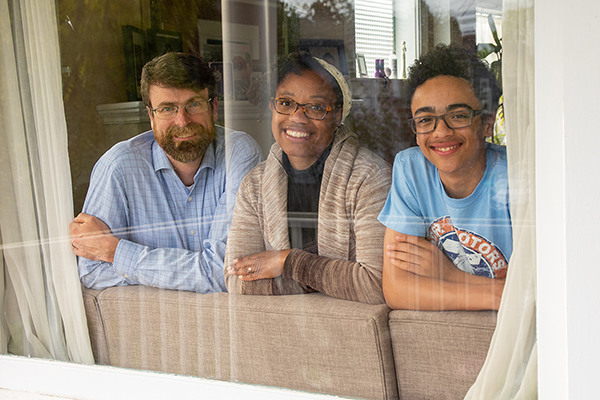
Story By Jenn Gidman
Images By Michael Schmitt
Michael Schmitt uses the Tamron 35-150mm VC OSD zoom lens to take families’ portraits from the other side of their windows.
View the last article from Tamron here.
Reflections on a Pandemic
Like many of us, when commercial photographer Michael Schmitt found himself suddenly confined to his home in Portland, Oregon, due to the coronavirus pandemic, he also saw much of the work he’d had lined up for the next few months vanish. Instead, his time in lockdown has been spent taking long walks with his camera—“at least I’ve been able to scout for future locations to shoot”—and with his children, an eighth-grader and high school senior, having longer meals and discussions together and expanding on the kids’ life skills. “Our boys are learning how to cook more than they ever knew how to,” he says.
Then one afternoon in mid-March, Michael was working in his yard when he happened to catch a glimpse of his son in the house, through a window. “That was the first weekend after school had been canceled,” he says. “We didn’t yet have a shelter-in-place mandate, but we were just starting to go into isolation mode. I happened to spot my son, with the reflection of my wife outside caught in the window, and I thought, ‘That would make a really cool image.’”
Michael decided to take other photos like that, but though he’d initially planned to photograph just his own family and some neighbors as a way to document this time in history in Portland, locals soon got wind of the project. “I’ve now photographed about 35 families,” he says. “And I’m not asking for payment for these portraits. This is a way for me to give something to people to remember this time by, as well as a way for me to stay creative while I’m not officially working.”
The Tamron 35-150mm VC OSD portrait zoom was the lens Michael opted to use for this project. “The color and definition quality this lens offers gives my images a timeless quality, which is exactly the look I’m going for,” he says. “That, in addition to the wide range of focal lengths at my disposal, plus the Vibration Compensation feature that allows me to shoot handheld without having to bump up the ISO too much, has made this the perfect lens for what I’m trying to capture with these images.”
It was the concept of the reflection that inspired the direction of the project. “I’m coming at it from a sociological point of view,” he says. “I’ve got my subjects on the inside of the home, but juxtaposed over them in the image frame are scenes of a world that they’re not supposed to go out into too much right now—but they can still see it, and eventually we’ll all get back out into it.”
What time of day Michael heads over to each family’s home depends on a variety of factors that allow him to use directional light to his advantage. “The first things I ask when I book the session include: Which way do your windows face, what does your yard look like, and what does your neighbor’s yard across the street look like?” he says. ‘For instance, if it’s an east-facing house, I’ll likely want to shoot there in the morning. Or if it’s a west-facing home, I don’t want to shoot too late in the day, because if there are big trees in the yard and there’s no light on them, they become an almost inky black, and I don’t get any reflections in the windows; all you see are black window panes.”
There are plenty of days in Portland when it’s cloudy, and Michael says that works for these types of images, but only if the home’s yard has closed foliage (i.e., plenty of trees) or another building that will show up in the reflection. “Otherwise, if there’s too much gray sky in the reflection, it washes my subjects out and you can’t really see anyone too clearly in the image,” he says.
How close or far Michael is from the window depends on how he wants to work the reflection into the picture, which often involves quite a bit of moving around until he finds the composition he likes best. “I’m usually about 3 to 5 feet away from the window, though I’ve done some photos where I’m only a foot or so away,” he says. “I also like experimenting with the different focal lengths of the 35-150 to see how the reflection shown in the window looks based on whatever focal length I’m using.”
Communicating with his subjects has been one of the most unique challenges for Michael while doing this project. “I’ll text the family when I arrive, because these days I don’t even want to knock on anyone’s door,” he says. “I’ll back up into the yard so they can come out on the porch, and together we’ll walk through a general idea of what we’re going to do, based on what the window looks like and how many people are going to be in the photo. Then, once they’re in the window, they’ll often just figure out themselves what positions to take and how to stand or sit. I’ll guide them with hand signals or go right up to the window and speak loud enough so they can hear me so I can guide them to make any needed adjustments.”
What Michael has found especially interesting as the project has evolved is that, despite the uncertainty and monotony that families are experiencing during this isolation, his images evoke feelings of positivity and togetherness. “I didn’t intend for the photos to go in that direction, but that’s just how it went,” he says. “Like those three women holding up all of those board games to the window—they’re all unemployed now, but they’re in that house together and making the best of the situation.”
In fact, Michael says his photo of seven college roommates “trapped” together in a house has been the image in this series that’s resonated the most with viewers on Instagram. “They’re Portland State University students who suddenly find themselves living in a confined space together and not really able to go out, as college students typically do,” he says. “But they say they’ve been getting along like family—and yes, that includes squabbling like siblings, but they also joke around a lot and have been having fun together. A friend of mine told me this is his favorite picture from the project, and when I asked him why, he said, ‘It feels inspirational. They all look happy, and it gives me hope.’”
Although the circumstances that drove this project aren’t ideal, Michael is grateful he’s been able to find a way to use this relative downtime to give something back to the community, keep people’s spirits up, and enhance his own photographic skills. “This has been a real lesson for me photographically,” he says. “I love figuring out little puzzles like this, and when I do figure out those puzzles, I want a lens I know can help me capture what I’m going for. That’s been the case with this 35-150 lens during this project.”
To see more of Michael Schmitt’s work, go to www.michaelschmitt.com.
